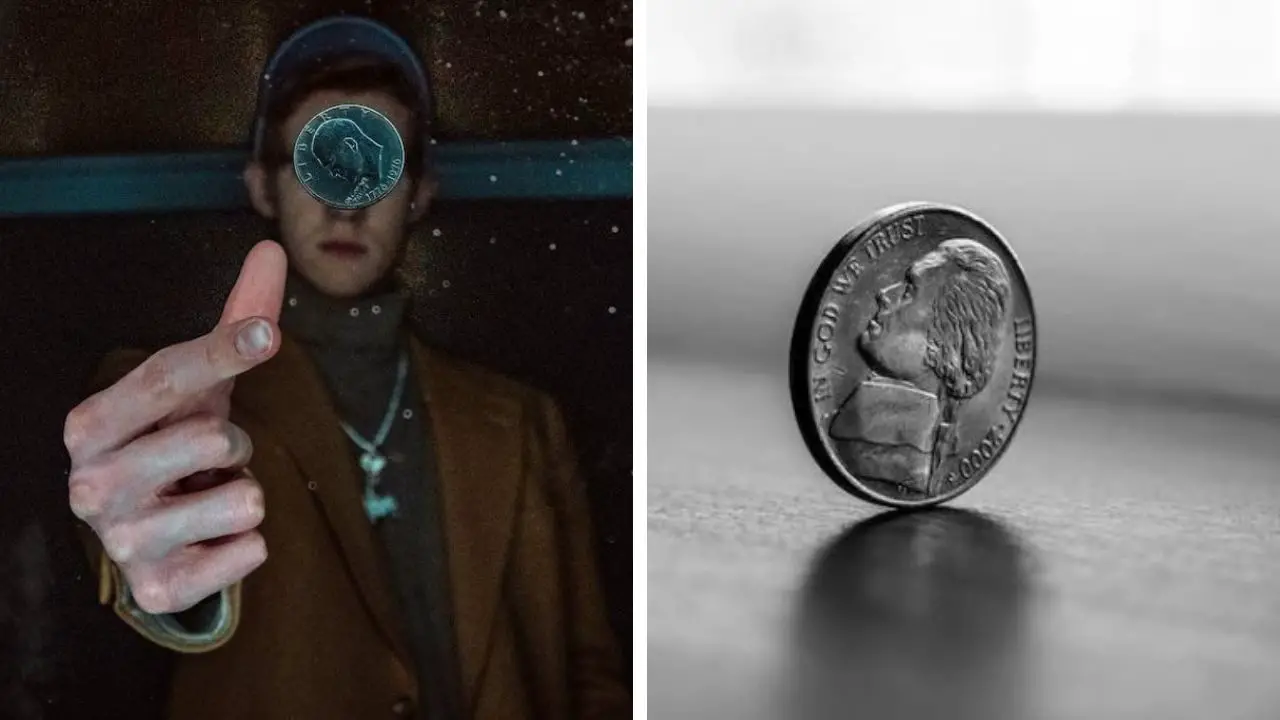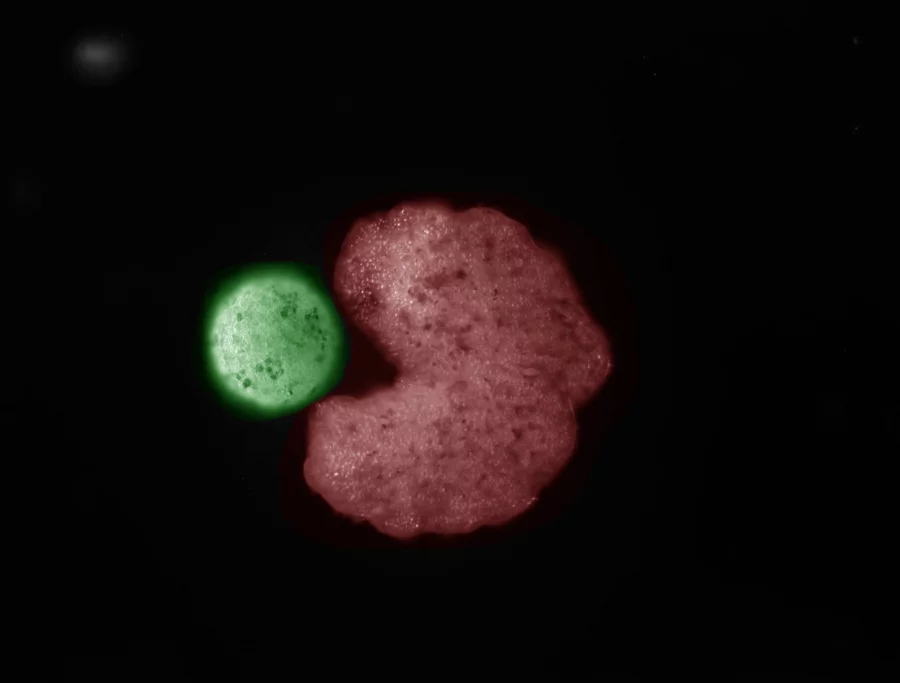Largest manta ray ever caught: Wingspan of 30 feet and weigh more than 6,000 pounds
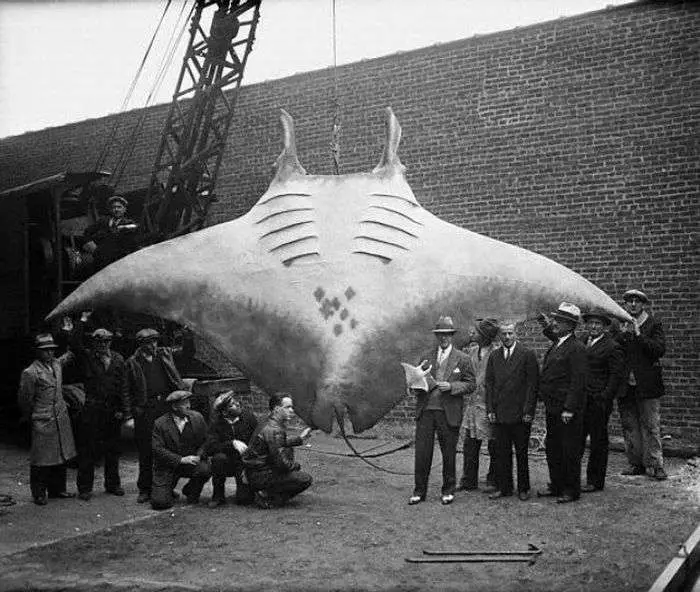
- Giant oceanic manta rays reach wingspans up to 30 feet.
- One specimen towed a boat five miles in a three-hour battle.
- Conservation efforts value each ray at $1 million in tourism revenue.
Imagine encountering a creature with a wingspan wider than a school bus, gliding silently through the ocean depths, yet feeding solely on microscopic plankton.
This is the reality of the giant oceanic manta ray, a species that has produced some of the most astonishing records in marine history.
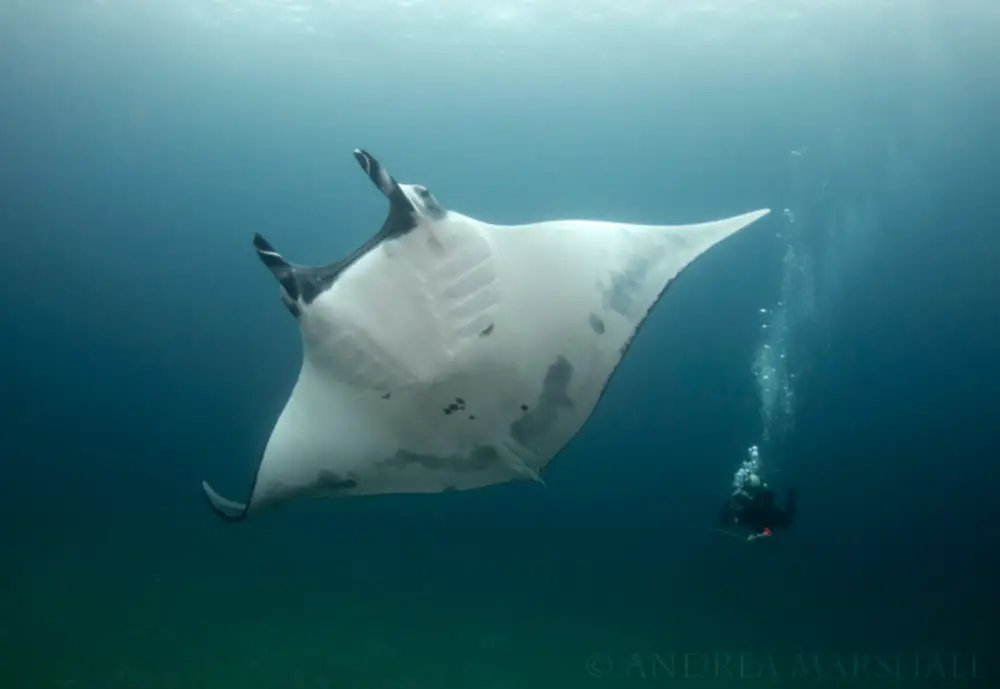
The 1920 record: A 30-foot-wide enigma
In 1920, a manta ray achieved legendary status. Its wingspan measured 9.1 meters (30 feet). This earned it the Guinness World Records title for the largest ray ever recorded.
The giant oceanic manta ray (Mobula birostris) typically spans 5.2 to 6.8 meters (17 to 22 feet). This specimen was exceptional.
Yet, its story is shrouded in mystery. No weight was documented. The location of the catch is unknown.
Was it netted by fishermen? Discovered stranded on a shore? The absence of details fuels curiosity.
This record underscores the immense potential size of manta rays. It remains a tantalizing, incomplete chapter in marine history.
| Detail | Information |
|---|---|
| Wingspan | 9.1 meters (30 feet) |
| Year | 1920 |
| Source | Guinness World Records |
| Location | Unknown |
| Weight | Not recorded |
The 1933 catch: A 6,000-pound struggle
On August 26, 1933, Captain A.L. Kahn set out for a routine fishing trip. Aboard his boat, the Miss Pensacola II, off New Jersey’s coast, he encountered a giant.
A manta ray became entangled in his anchor line. It weighed between 5,000 and 6,000 pounds.
Its wingspan stretched 20 feet 5 inches. For three grueling hours, the ray towed the boat five miles.
Kahn feared for his vessel’s safety. The Coast Guard was called. They fired 20 bullets to subdue the creature.
The catch sparked a frenzy. In Brielle, New Jersey, Kahn displayed the ray. He charged 10 cents per view.
The proceeds funded a $3,000 fire truck for the local fire department. The ray was later taxidermied.
It was exhibited in New York City. Kahn intended to donate it to a natural history museum, though its final resting place is unclear.
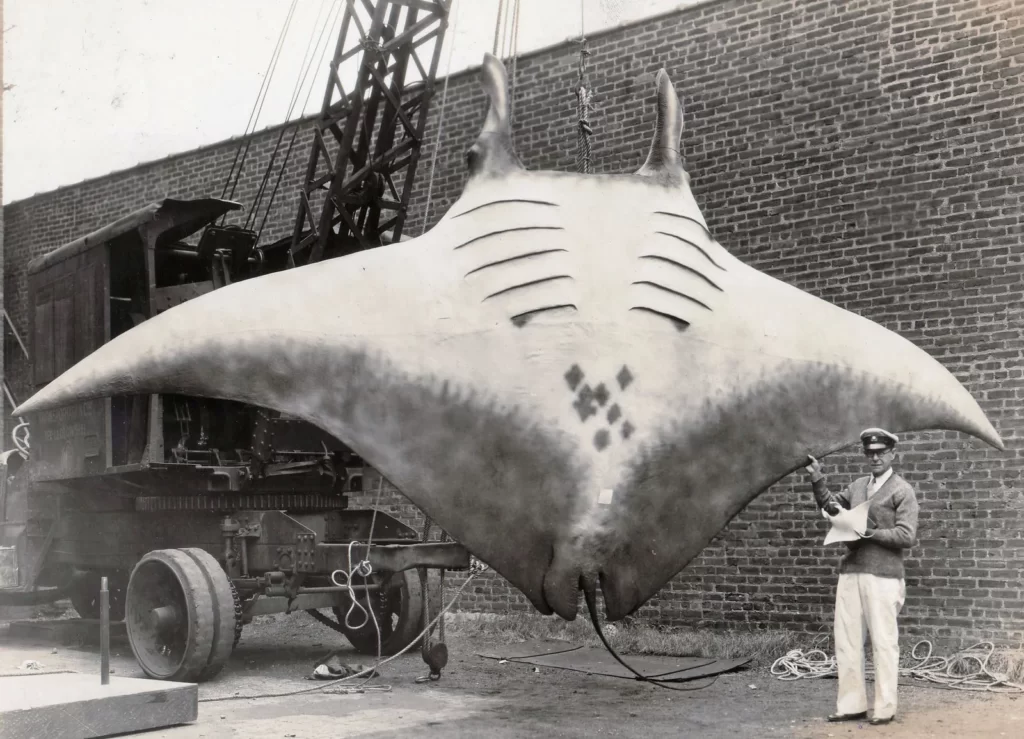
A photograph of the taxidermied ray, verified by Snopes, remains iconic. Some sources confuse the location with New Brunswick, Canada. Contemporary reports confirm it was New Jersey.
| Detail | Information |
|---|---|
| Weight | 5,000–6,000 pounds |
| Wingspan | 20 feet 5 inches |
| Year | 1933 |
| Location | Off New Jersey coast, near Brielle |
| Captor | Captain A.L. Kahn |
| Outcome | Displayed, taxidermied, exhibited in NYC |
These historic catches highlight the immense scale possible for giant oceanic manta rays, scientifically known as Mobula birostris.
Typically, adults span 17 to 22 feet, but exceptional individuals push boundaries, with weights reaching up to 6,600 pounds in verified studies.
Their flat, diamond-shaped bodies and triangular pectoral fins enable effortless propulsion, while cephalic lobes—often called “horns”—funnel water into gill slits for feeding.
Despite their imposing presence, these rays pose no threat to humans, earning the misleading nickname “devil fish” from early observers.
Delving deeper into their biology reveals a creature of remarkable adaptations.
Giant oceanic manta rays inhabit tropical and subtropical pelagic zones, migrating across vast distances in search of nutrient-rich upwellings.
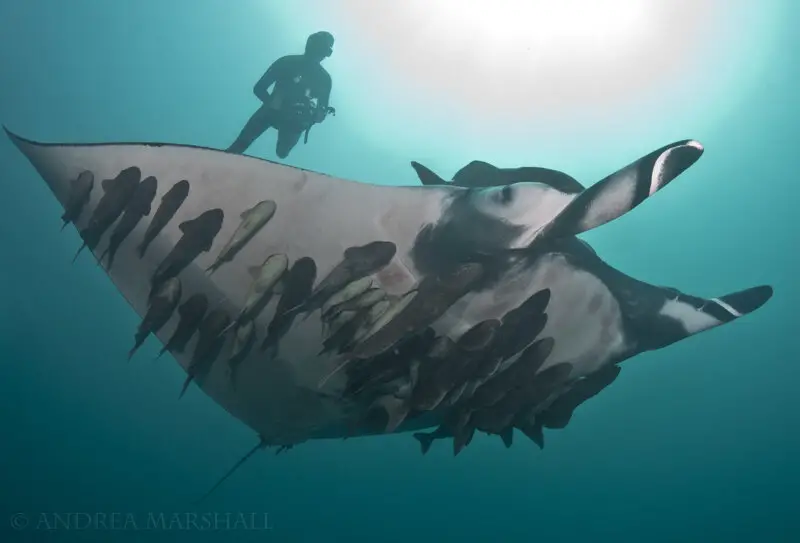
Filter feeders by nature, they consume zooplankton such as copepods and krill, ingesting roughly 12 percent of their body weight each week through specialized gill rakers that trap prey while expelling water.
This diet sustains their massive frames, which can grow to 29 feet in rare cases, as documented in global sightings.
Their intelligence sets them apart in the underwater world.
Boasting the highest brain-to-body mass ratio among all fish species—surpassing even many sharks—these rays exhibit behaviors suggestive of advanced cognition.
Observations indicate potential self-recognition in mirrors, a trait shared with dolphins and elephants, and they display curiosity toward divers, often approaching for interaction.
Reproductive strategies further underscore their vulnerability: females carry a single pup for 12 to 13 months, birthing live young every two to three years.
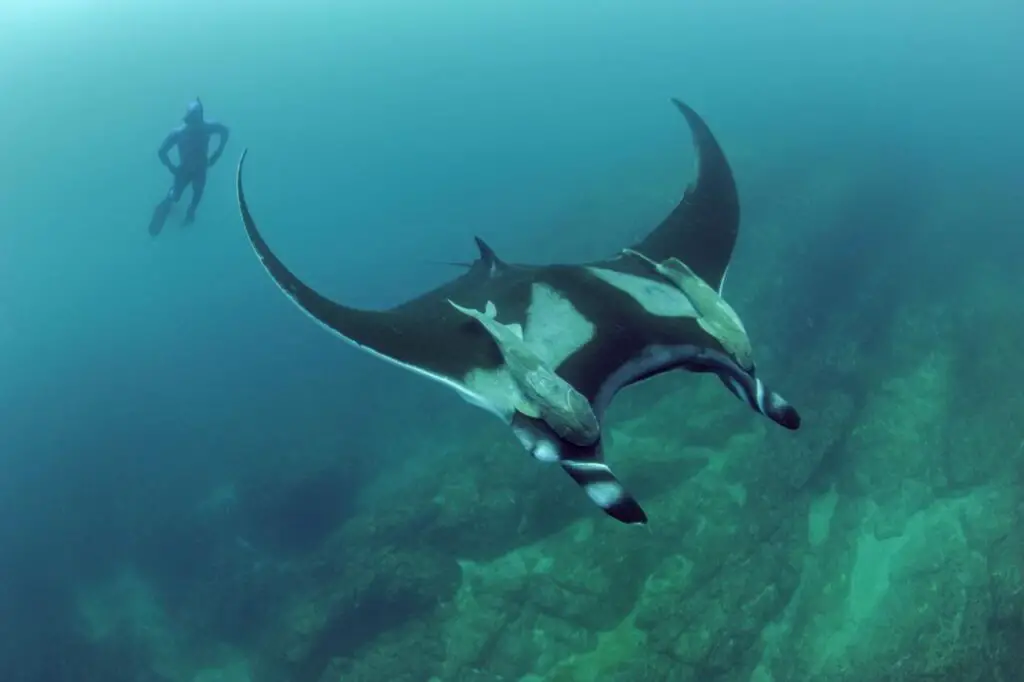
Newborns emerge fully formed at about 4 feet 7 inches wide, ready to fend for themselves without parental care.
Lifespans extend beyond 45 years in monitored populations, allowing for gradual population growth under ideal conditions.
Behavioral patterns add layers of fascination. While often solitary, manta rays congregate in feeding aggregations or at cleaning stations where smaller fish remove parasites from their skin.
Spectacular breaching leaps, where they launch entirely out of the water, may serve purposes like communication, courtship, or dislodging irritants—though scientists debate the exact motivations.
In coastal habitats, reef manta rays (Mobula alfredi) favor shallower reefs in areas like Indonesia and the Maldives, contrasting with the open-ocean wanderings of their oceanic counterparts.
To encapsulate key dimensions of these marine giants, consider the following comparative stats:
| Aspect | Giant Oceanic Manta Ray | Reef Manta Ray |
|---|---|---|
| Average Wingspan | 17-22 feet | 10-18 feet |
| Maximum Wingspan | 30 feet | 18 feet |
| Average Weight | Up to 3,000 pounds | Up to 2,900 pounds |
| Maximum Weight | Over 6,600 pounds | Around 4,400 pounds |
| Lifespan | Over 45 years | Up to 40 years |
| Daily Zooplankton Intake | 60-70 pounds | 40-50 pounds |
These figures, drawn from extensive field research, emphasize the oceanic variant’s superiority in size and endurance.
FISH Size Comparison | 3D Animation Size Comparison
Shifting focus to modern encounters, recent incidents underscore ongoing interactions between humans and these behemoths.
In 2015, off Peru’s northwest coast, fishermen accidentally netted a manta ray estimated at over 2,200 pounds, though its wingspan fell short of historic records at around 20 feet.
Such bycatch events highlight persistent risks in commercial fishing zones.
Similarly, in 2020, Indian Ocean trawlers hauled in specimens weighing 1,650 pounds, prompting calls for stricter gear regulations to prevent entanglements.
Conservation challenges loom large amid these tales of grandeur.
Overfishing targets manta rays for their gill plates, valued in unregulated markets despite lacking scientific backing for medicinal claims.
The International Union for Conservation of Nature classifies them as endangered, with global populations declining by up to 30 percent in recent decades due to habitat disruption and climate-driven shifts in plankton blooms.
In the United States, the species gained threatened status under the Endangered Species Act in 2018, prohibiting possession and trade while mandating federal agencies to assess impacts on critical habitats.
Innovative protections offer hope. Indonesia’s 2014 nationwide ban on manta fishing transformed the narrative, prioritizing ecotourism over exploitation.
A single ray’s lifetime contribution to dive tourism can exceed $1 million, dwarfing the $500 fetched from a one-time harvest.
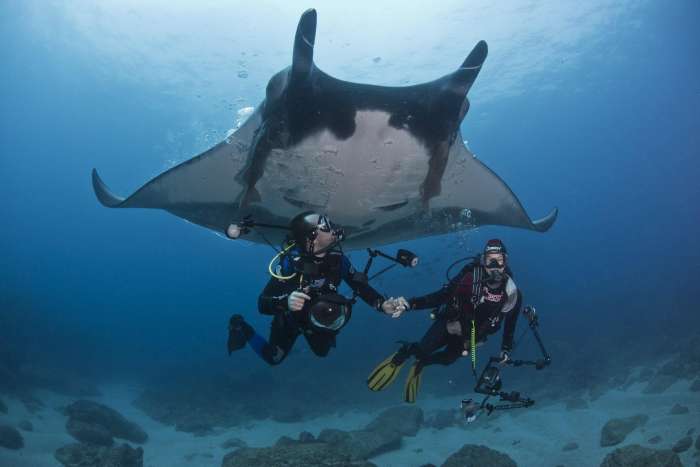
In Raja Ampat, marine protected areas have spurred a 10.7 percent annual population increase from 2009 to 2019, as tracked by photo-identification programs.
Organizations like the Manta Trust deploy acoustic tags to map migration routes, revealing connectivity between feeding grounds in the Gulf of Mexico and breeding sites in the Caribbean.
Yet, mysteries persist. How do warming oceans alter their migratory paths, potentially exposing them to new threats?
Researchers in Hawaii monitor aggregations exceeding 100 individuals, using drone surveys to quantify responses to coral bleaching events.
In Florida, projects catalog thousands of unique spot patterns on ray undersides—nature’s equivalent to fingerprints—for long-term tracking.
As climate models predict a 20 percent drop in zooplankton productivity by 2100, the implications for these filter feeders grow urgent.
What undiscovered giants might still roam unexplored depths, awaiting the next chapter in this oceanic saga?
























